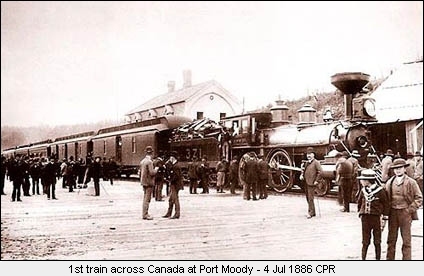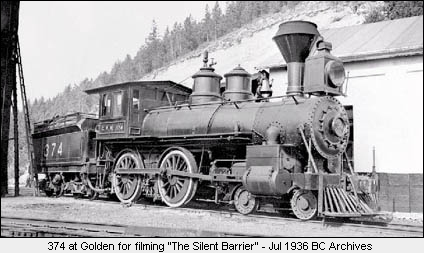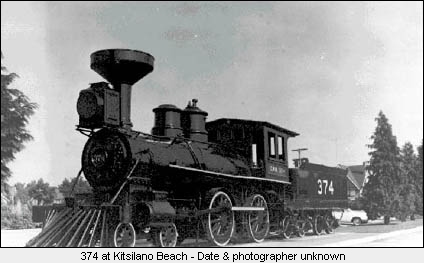Vol. 17 No. 5
May, 1987
|
Stay Safe in 87
|
|

Vancouver's
Restored "374"
Valued Artifact
|

Omer Lavallee
|

With Expo 86 under its belt, the City of Vancouver is turning its attention towards
23 May 1987, the centennial of the arrival of the first train into the current downtown area.
The first scheduled transcontinental train - a nationally-significant event - had arrived at nearby
Port Moody 11 months before, on 4 Jul 1886.
This train was pulled from North Bend to Port Moody by 4-4-0 class S.C. steam locomotive No. 371, built
at the CPR's new shops in Montreal in May, 1886. No. 371, by the way, was the last of 24 locomotives which pulled
the train right across the country, power being changed at the end of each 200-kilometre subdivision.
No. 371 remained in service for 30 years. About 1905, the railway started a program to rebuild obsolescent
locomotives, but No. 371 was judged to be in too poor condition for this treatment. It was broken up in October,
1915.

When the 19-kilometre Vancouver extension was opened for scheduled service a century ago, the
locomotive, which was placed at the head of the train at North Bend, was No. 374, a sister engine built in June,
1886.
This engine escaped the fate of No. 371, being completely rebuilt in September, 1914. the work done on the locomotive
included the replacement of the boiler, firebox, smokebox, cylinders, and wheels with new ones reflecting current
technology. In fact, the only major piece of the original locomotive to be retained was the frame. By then carrying
the number 158, it remained in service until July, 1945.
At this time, one Vancouverite who was aware of the original identity of No. 158 was Major J.S. Mathews, the city's
archivist. Canadian Pacific received a request for the donation of the erstwhile No. 374 to Vancouver, to which the
company agreed.

Before shipment, an attempt was made at a cosmetic "restoration" to give the locomotive an
"old-time" appearance. The result of this well-intentioned but regrettable
exercise was to give the locomotive an appearance that it never had. In a word, the result was neither "old
374" nor latter-day No. 158.
The "restored" locomotive was shipped from Angus Shops to the West Coast in 1946. It found a permanent
resting place on an isolated stretch of track at Kitsilano Beach. There it languished for nearly four decades,
forgotten and neglected.
One Halloween early in the 1950s, pranksters gave No. 374 an orange paint treatment. The incident prompted me to
write a rather vitriolic letter to the press with a copy to Vancouver's mayor, then Fred Hume.
My action was followed by an appreciative letter from Major Mathews, who hoped that it would galvanize municipal
officials into taking some action to preserve the locomotive. To the surprise of absolutely no one, nothing happened.
Early in the 1980s, a group of railway buffs rescued No. 374 with the aid of a grant from the City of Vancouver.
Moved to the shelter of a shed on Granville Island, it was splendidly refurbished right down to a replica oval
builder's plate. Then, in 1985, it was moved to its Expo 86 locale, where it was placed on a turntable outside of
the rebuilt roundhouse.
"Old 374" is still there, and from reports I've had from the Pacific Coast, the City of Vancouver has
backed away from an earlier agreement to place the locomotive inside the roundhouse. Instead, some sort of roof is
to be constructed over its current position on the turntable.
Considering the significance of this artifact to the city, and the neglect it suffered in the 40 years outside at
Kitsilano Beach, I hope my information is wrong.
This CP Rail News article is copyright
1987 by the Canadian Pacific Railway and is reprinted here with their
permission. All photographs, logos, and trademarks are the property of the Canadian Pacific Railway
Company.
|